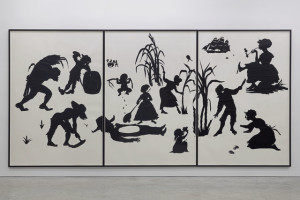At first glance, Kara Walker’s work look like an illustration from a quaint fairytale. It’s only upon further inspection that you realize that there is something horribly disturbing about the scenes she has portrayed so beautifully. As an African- American, female artist, Walker creates pieces that are laden with questions about race, sexuality, and American history.
Walker was born in Stockton, California in 1969, and quickly took a liking to art. Her father was a painter, and she initially stuck to the more conventional, “fine art” that has always been so popular. She attended college in Atlanta, earning a degree in fine art, and soon after obtained a masters degree from Rhode Island School of Design. At this point, Walker had experimented with different forms of media, and began displaying her now trademark style of large, black, paper silhouettes against a stark white background. Walker also remarked that the primary content of her pieces–“pictures that told stories of things—genre paintings, historical paintings”— was developed in her teenage years.
One of the artist’s first major exhibitions was in 1994 in New York City. Titled “Gone: An Historical Romance of a Civil War as It Occurred Between the Dusky Thighs of One Young Negress and Her Heart,” Walker manages to convey the horrid realities of slavery in a single, elegant image. The piece really does tell a story– I feel like it can be read from left to right, your eyes first noticing the wealthy, Antebellum-era couple and then ending with the sweeping female slave.
Though the images may be disturbing, the message is incredibly important, and work to “simultaneously seduce and implicate the audience.” Critics and audiences alike recognized her clever approach to such dark parts of American history (and sadly our present, too), leading Walker to have many exhibitions across the United States and England. In 2007, TIME magazine named her one of the 100 most influential people of the year. But, her popularity didn’t guarantee relief from criticism. Her work was boycotted by older black artists who believed her depictions of African Americans were offensive. Just recently, in 2012, one of her murals– in which a black slave is forced to engage in sexual activity with her presumed black master– was covered up in Newark Library in New Jersey. It has since been revealed again.
Confectionary, 2014
This is one of Walker’s more recent pieces. Still utilizing her recognizable style, she creates a narrative so depressing, but fascinating. As with her other works, the meaning is often clearly stated in the title. In this case, the title “Confectionary” is meant to be a wry, ironic glance into what goes into making the daily pleasures we consume every day. She examines this in a historical context, with black slaves harvesting sugar cane that will undoubtedly only be consumed by their white oppressors, but the idea can be applicable to current American life, too. It’s jarring to think that the shirt on someone’s back, labeled with a tag stating “MADE IN CAMBODIA”, was probably produced in terrible conditions, by people who are facing extreme injustices. The mild conveniences of one group are so often created by exploiting the unfortunate circumstances of others, which Walker realizes and epitomizes with her images of the pre-Civil War South.
I think one of the greatest compliments Kara Walker would like to hear about her work is that it inspires action, and I really think it has the power to do just that.
Sources:
http://www.biography.com/people/kara-walker-37225#career-success
http://www.pbs.org/art21/artists/kara-walker
https://www.artsy.net/artist/kara-walker




This is awesome! I personally love when artists use their work to make a statement and with the hope of creating action! Artists work with platforms that are perfect for this, so when they don’t utilize it, it’s a shame. (Obviously they don’t have to all the time, but I just think it’s really influential when they do.) Walker’s art is really interesting and original. I love the plain black and white that she uses because it really creates a stark contrast and definitely makes you focus on the message a lot more. The first piece that you showed was my favorite because of the fluidness of the story, like you talked about. She makes really interesting transitions and her stories and points are so important.
I really liked reading this post! I think it was a great reminder to look past the beauty of a painting, and really search for the deeper meaning. If there was one suggestion I would give you, it would just be to try and make it easier for the audience to read. At some points, it could just feel like a history book, or an art history textbook, and although that works to some extent, it could also turn an audience off.